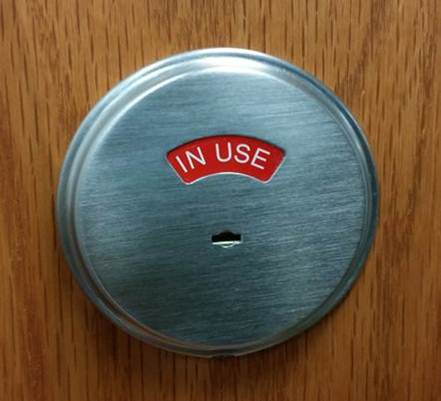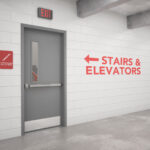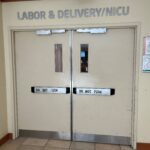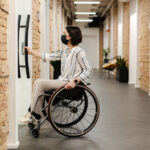Last fall, I taught a 2021 code update class for the DHI conference, and I mentioned a code change that would require privacy sets on individual restrooms to have indicators. Because the publication date of the International Building Code (IBC) was delayed, I had to teach the class without actually seeing the 2021 code. As it turns out, the IBC requirement for an indicator doesn’t apply to ALL single-user restrooms, only to the family or assisted-use toilet and bathing rooms that are most commonly found in assembly and mercantile occupancies.
I can’t think of a good reason why a privacy indicator would be important for one type of single-user restroom and not others…I think the code was changed in this way because there is a section specific to family and assisted-use restrooms. Regardless, the indicator is a good idea, but not a code requirement for other types of single-user restrooms. The proposal for the International Plumbing Code, which would have required indicators for all single-user restrooms was not approved.
 Here’s the original post, which I have edited to reflect the correction:
Here’s the original post, which I have edited to reflect the correction:
I’m often asked whether there is a model code requirement specific to the lock function used on single-user restroom doors, and whether an indicator is required. To date, I have only seen a few state and local requirements, but the 2021 edition of the IBC includes a change that will mandate an occupied indicator on some single-user toilet rooms:
1110.2.1.6 Privacy. Doors to family or assisted-use toilet and bathing rooms shall be securable from within the room and be provided with an “occupied” indicator.
A change proposed for the 2021 International Plumbing Code (IPC) would have required occupied indicators for all single-user toilets, but this change was not approved. However, the reason statement that accompanied the code change proposal illustrates the need for these indicators, stating:
 This code change proposal will alleviate privacy and safety concerns by requiring the occupied indicator for single-user restrooms. Without an occupied indicator, the only way for someone to see if the room is in use is to turn the handle. This causes safety and privacy concerns for the user. This can cause severe discomfort, even fear, for children or people who have suffered trauma. This proposal will proactively provide increased comfort and safety for everyone.
This code change proposal will alleviate privacy and safety concerns by requiring the occupied indicator for single-user restrooms. Without an occupied indicator, the only way for someone to see if the room is in use is to turn the handle. This causes safety and privacy concerns for the user. This can cause severe discomfort, even fear, for children or people who have suffered trauma. This proposal will proactively provide increased comfort and safety for everyone.
And now…a question for you:
Imagine a college dormitory, which has 2 single-user toilets in the common area. All of the other restrooms are only available to students who live in the dorm – not to visitors. The 2 common-area restrooms have privacy sets, which can be unlocked from the outside with a small screwdriver.
As you are probably imagining, students sometimes open the restroom doors when their friends are inside – a privacy set does not guarantee privacy when there’s an opportunity to prank your friends and videotape the results.
Which lock function would you suggest? WWYD?
A few things to consider:
- Is access to a restroom a requirement, or could these doors be locked “gas-station style” with a key available at the desk?
- Is it important to be able to access the room quickly (with a screwdriver), in case someone in the restroom needs help, or is a key acceptable?
- What type of lock would you use to help ensure privacy/security, safety, and code-compliance?
Please share your insight!
You need to login or register to bookmark/favorite this content.





We had a problem with “Staff Only” single user toilets in the hospital I worked in. Initially, they were built with cylindrical Storeroom function levers keyed to an access key that all of the staff carried. Needless to say, there were a lot of surprise walk-ins with this setup.
Afterwards, we put combo locks in place of the leversets (to keep the public out), and a single cylinder deadbolt for privacy, keyed to an emergency key that only the floor supervisor and the security guard held.
How often do people need help when in a restroom? I say put a keyed lock on it with an indicator.
I have been asking my Allegion rep. for a few years on why schlage does not offer cylindrical lock with occupancy indicator. Since there is a company out there that does I have been force to use them thru Amazon. I service gas stations and the most common function I use on single use restrooms is a corridor function. This way door can be secured if needed.
I recall a previous post of yours about single-user restrooms and egress. Do these doors require one motion for egress even though the occupancy is for one? The model codes at the time did not specifically address this issue. Since reading that I have been specifying mortise privacy locks with an occupancy indicator to be on the safe side.
Hi Eric –
The model codes still require one operation to unlatch these doors. NFPA 101 includes an exception for existing hardware on doors serving rooms with an occupant load of 3 or less, but I don’t think the intent is to allow new hardware that would require more than one operation to unlatch the door.
– Lori
I like to use a passage with the Schlage B571 door bolt.
Thanks Jeff –
In most locations, these doors have to unlatch with one releasing operation, so the separate passage set and deadbolt may be non-code-compliant unless the AHJ approves the application.
– Lori
If not mistaken two operation is acceptable for occupancy of three or less under NFPA 101. See 2015 7.2.1.5.10.6. If so, single use toilet could have an indicator dead lock presently.
Hi Tony –
This section of NFPA 101 applies to existing hardware on rooms with an occupant load of 3 or less – typically it would not permit the installation of new hardware that requires 2 operations to unlatch. And this would only be applicable where NFPA 101 is the adopted code. Here’s the paragraph:
7.2.1.5.10.6 Two releasing operations shall be permitted for existing hardware on a door leaf serving an area having an occupant load not exceeding three, provided that releasing does not require simultaneous operations.
– Lori
It seems to me that this should be a mortise privacy lock or an interconnected lock with an occupancy indicator that can allow egress from inside the toilet room by operating the lever only, single action.
I think it depends on the situation if you should be able to keep the doors locked all of the time or if a key should be required. Assisted Living, not usually locked and a coin turn to get in quick could be ok. Coffee shop where people could be doing drugs, I would go with something locked all of the time with a keypad or card reader for entry and a key entry function for staff only.
I would go with an office function mortise lock with an ADA thumb turn and an occupancy indicator as a standard.
How would you add an auto operator to single occupancy toilet door? Just curious.
Hi Leah –
There are some good suggestions here about the auto operator: https://idighardware.com/2017/07/wwyd-single-restroom-with-automatic-operator/, and a good option here: https://idighardware.com/2018/02/restroom-kit/.
– Lori
Showing the separate indicator deadbolt and mentioning the need to “turn the handle” in the reason statement seems to indicate that the code change will ignore the “single action to unlatch the door” requirement. Is that a reasonable interpretation? We are frequently asked to install B571’s in addition to existing levers and have always declined, opting instead to install an interconnected lock with indicator. If the one motion requirement can be ignored it will be an easier (and less expensive) option for our customers.
In your dormitory common area scenario there are probably several good options but one possibility is the Alarm Lock DL4100/DL4500 privacy function keypad lock.
Hi Jim –
I don’t think the intent of the code change is to allow 2 releasing operations. The indicator deadbolt could be used if there isn’t another lock or latch on the door, but otherwise, I think the intent is to use a lockset/privacy set with an indicator.
– Lori
I recommend the Restroom Deadbolt Indicator (RDI) from Architectural Openings. This is an aftermarket occupancy indicator accessory for use with Schlage B or Falcon D Series single cylinder deadbolts. In the case of the college dorm, the lock cylinder could be keyed to the building master or an emergency key so that only an authorized individual could unlock the occupied toilet in an emergency. I have installed these in church restrooms and they work well. See pdf sell sheet here:
https://www.indicatordeadbolt.com/wp-content/uploads/2019/02/Restroom-Deadbolt-Indicator-Sell-Sheet-2-19.pdf
My 2 cents:
1. Occupancy indicators are a good idea.
2. The single occupancy restroom should be considered a dwelling unit for egress purposes and allow 2 actions to egress.
3. On the prank my intuition may be different from others, but i don’t see a hardware problem and would not recommend a hardware solution.The prank- at least in my part of the world- would only mildly irritate the person using the single occupancy toilet, and posting the silly video would have a quite a negative impact on the prankster.
Thanks for asking,
Lloyd
Thanks Lloyd! Currently, the US model codes would require restroom doors to unlatch with one operation – they don’t fall under the same exception as dwelling units and sleeping units.
– Lori
Correct,i’m recommending a change. The logic behind allowing two actions to egress from a dwelling units is (1) additional security is required for the occupant to sleep well, and (2) the occupant locks the door themselves, so they are familiar with the operation and they know the door is locked. The single occupancy restroom is a similar situation, and more good than harm is done by allowing a second lock.
Thanks
Oh – ok! I don’t disagree with you but a code change would have to be made. I’ll put it on my list to discuss with BHMA.
– Lori
Corridor with occupancy indicator.
What would you suggest when the project calls for grade 1 cylindrical locks with an occupancy indicator? (specifically the vacant/occupied indicator). We are having this issue with increasing frequency. Thank you
Hi Heather –
Right now I usually see mortise locks on those doors, but hopefully there will be a good cylndrical option in the future.
– Lori
Cylindrical levers with occupancy indicators have been available for a while from
https://vizilok.com/pages/why-buy-indicator-locks-1
We furnished 4 for a New York City shared space and 1 of them failed. We had bought two additional for stock, so we sent one of our stock locks out for a field replacement, and Vizilock made good on the other lock shortly thereafter. We put the other lock on the door from our office to warehouse to test it’s durability, and it is doing fine.
Since then, I furnished another two of the heavier duty version and I haven’t had any complaints. For the price and the cylindrical prep, it’s a good product. At the time, their interior privacy push button was not ADA compatible, but they have since fixed that. Also, be careful as some models were handed. I am not sure if they still are. I also remember something about fire rating. They may not have tested yet, but that was a year ago.
Vizi locks are not grade 1 and when I asked about it, they asked me to send them spec’s.
I’m glad you’ve had good luck with them. They don’t last 6 months at my facility. I’ve been on ASSA Abloy and Schlage to make a grade 1 cylindrical indicator lock for years. The first one that can make it work will corner the market!
Also not available in fire rate version.
I agree with Heather. We are seeing more requests for cylindrical locks with occupancy indicators.
That said, how is a restroom any different than any other locked door? If it’s a keyed function, you need a key to get in during an emergency. If an electrician is working in an electrical room that typically has a storeroom lock or an exit device with night latch function trim, a key is required if there is an emergency in that room.
Taking this one step further, I think requiring an indicator on single use restrooms is crazy. Are they going to require indicators on toilet stalls too? In many cases, the stall doors don’t remain open when unoccupied (due to installation and/or wear and tear) so we often have to try to open a stall door to find out whether it is occupied or not. Or look underneath for feet (which may not be visible in an elementary school). While catering to those with anxiety is a good gesture, where do we draw the line?
This is a topic that we have worked with -A Lot! in our school district.
Nobody likes to be doing their daily and have someone rattle the lever, or even worse-A walk in.
This is not a simple issue for us anymore as we have been mandated to provide “Gender Neutral ” washrooms in all of our schools. This is the hardware that we use on our single user washrooms:
K-7-Schlage ND73 Inside push button, outside keyed to Classroom key for emerg. staff entry
K (in classroom) ND40 Privacy.
Grade 9-12 ND70 lever keyed to the school master for engineering lockout only,
AND B-570 Deadbolt for use as privacy. Also keyed to the school master for emerg. entry.
Staff only washrooms Schlage ND80, keyed to Classroom (carried by all staff) key, AND B571 Indicator Bolt.
We have special labelling above the locksets to advise staff, and the keyway on the 7-12 deadbolts is covered by an “Emerg” label.
I really wish that a 500 series deadbolt was available with an indicator and a keyed cylinder for emergency entry.
the B-571 works fine for very occasional use but is not strong enough for more than that.
Mortise locks are not an option for retrofit due to their cost.
I will send Lori a couple of pictures to add to this comment
We’ve made good use of Alarm Lock 4100 keypad on staff restrooms, lactation, shower and sleep rooms in public locations.
The Managers and Asst. Managers have an over-ride code for emergency entrance.
I encourage the sign department to not advertise the room use, just a room number. Staff knows it’s a toilet, shower or whatever.
There is a company in Oregon (BMS) that takes a Falcon D271 and modifies the latch using a magnet to hold the indicator in place, then it will release and re-set the indicator as the door is opened. This allows the single motion egress when used with a separate cylindrical privacy or lock set.
Thanks Kurt! I actually wrote about that modification here: https://idighardware.com/2019/08/indicator-deadbolt-2/
– Lori
The single motion cylindrical lock solution adopted by local school boards for single occupancy staff washrooms is Schlage CO100-CY-40-KP, The exterior is always secure.
A valid code (apparent above the outside escutcheon -for public use) will engage the lever and allow entry.
On entry and the door in the closed position, pushing the interior push-button illuminates RED on the outside escutcheon & freezes the keypad, preventing surprise entries, until the interior lever is used and the door opens.
Emergency access by key over-ride or Pass-Thru numeric code
I can see Schlage introduce a Grade 1 interconnected lock with an indicator somehow built in. I have been using mortise locks on institutional work and Falcon H2171 for medium construction and multi-family.
For the dormitory scenario, what about the Schlage CO-200 with privacy and indicator?
I feel that in this situation it’s going to vary, but most of the time, in most situations, I feel the need for quicker access more important than weighing the risk of a bad prank and will even use the coin turn over the emergency key. Exceptions are places where things like pranks and bullying outweigh the probability of a fall risk (almost any education, including college dorm buildings). I put coin turns/screw driver on day cares and hospitals though unless instructed otherwise. As for keyed, I do that by request only (typically faculty/staff restrooms in schools and mental institutions).
I’ve challenged architects to gain entry to the coin locks on a walk-through and then laugh when they can’t. Our employees wear scrubs and NO ONE carries change, making the locks impossible to open in an emergency.
Great feedback – thanks!
– Lori
Lori – Is there any exception for locking on Pre-School and 4K toilet room doors? Many of the schools and daycares we’ve consulted on do not want the younger kids to be able to lock the door, so we typically specify and supply passage sets.
Hi Bill –
I don’t know of a specific exception for that application, although a modification could be made locally.
– Lori
I haven’t read all the comments yet but has lack of Braille been addressed?
The lack of braille on the occupancy indicator? Do you think that is a requirement? I was looking for something a while back about braille on the keypad buttons on a lock or access control reader, but couldn’t find anything. I’d love your take on it.
– Lori
the industry is being blindsided with all the requirements
If no indicator is required, the simplest solution is to use a corridor function lockset. It works just like a privacy function with a restoring push button, but there is a cylinder in the outside lever. Since the restrooms are in a dormitory, this lock function may already be in use in the dorm.
We use a few different manufactures on campus (NOT BY CHOICE), but all locks are Mortise. For single occupancy restrooms we will use a privacy lock that has an indicator but uses a keyed cylinder for override. We also have Quiet/Lactation rooms that use either a Hotel Function lock with an indicator or a Privacy Function Standalone Keypad lock that has a key override. The key to these locks is one that is restricted in to who can have it within the building and also on our First Responder District ring.
Thank you for sharing your insight!
– Lori
This change doesn’t sound like an ADA or immediate hazard situation, so it shouldn’t apply retroactively. Correct?
Hi David –
I don’t think that the intent is for this to be applied retroactively, although there could be some situations where the AHJ requires it.
– Lori
HI,
Here you have a Cal-Royal Indicator lock ADA approved, Grade 2. https://www.cal-royal.com/products/locksets/grade-2-locksets/p-252-jhil-series
and then next there will be mandated latch/bolt retraction from the inside, not something that is current with the displayed indicator bolt.